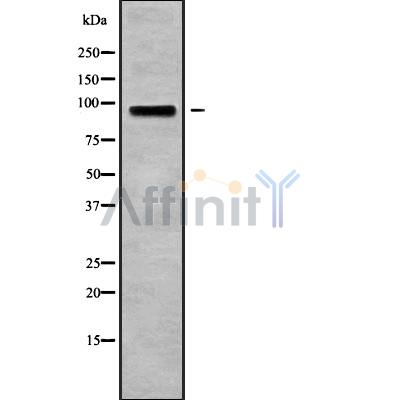CSF3R Antibody - #DF9543
| Product: | CSF3R Antibody |
| Catalog: | DF9543 |
| Description: | Rabbit polyclonal antibody to CSF3R |
| Application: | WB |
| Reactivity: | Human, Monkey |
| Prediction: | Pig, Bovine, Horse, Sheep, Rabbit, Dog, Chicken |
| Mol.Wt.: | 92 kDa; 92kD(Calculated). |
| Uniprot: | Q99062 |
| RRID: | AB_2842739 |
Related Downloads
Protocols
Product Info
*The optimal dilutions should be determined by the end user. For optimal experimental results, antibody reuse is not recommended.
*Tips:
WB: For western blot detection of denatured protein samples. IHC: For immunohistochemical detection of paraffin sections (IHC-p) or frozen sections (IHC-f) of tissue samples. IF/ICC: For immunofluorescence detection of cell samples. ELISA(peptide): For ELISA detection of antigenic peptide.
Cite Format: Affinity Biosciences Cat# DF9543, RRID:AB_2842739.
Fold/Unfold
CD 114; CD114; CD114 antigen; Colony stimulating factor 3 receptor (granulocyte); Colony stimulating factor 3 receptor; CSF 3R; CSF3R; CSF3R_HUMAN; Csfgr; G CSF R; G-CSF receptor; G-CSF-R; GCSFR; Granulocyte colony stimulating factor receptor; Granulocyte colony-stimulating factor receptor; OTTHUMP00000009703; OTTHUMP00000009704; OTTHUMP00000009705;
Immunogens
A synthesized peptide derived from human CSF3R, corresponding to a region within the internal amino acids.
One or several isoforms have been found in myelogenous leukemia cell line KG-1, leukemia U-937 cell line, in bone marrow cells, placenta, and peripheral blood granulocytes. Isoform GCSFR-2 is found only in leukemia U-937 cells. Isoform GCSFR-3 is highly expressed in placenta.
- Q99062 CSF3R_HUMAN:
- Protein BLAST With
- NCBI/
- ExPASy/
- Uniprot
MARLGNCSLTWAALIILLLPGSLEECGHISVSAPIVHLGDPITASCIIKQNCSHLDPEPQILWRLGAELQPGGRQQRLSDGTQESIITLPHLNHTQAFLSCCLNWGNSLQILDQVELRAGYPPAIPHNLSCLMNLTTSSLICQWEPGPETHLPTSFTLKSFKSRGNCQTQGDSILDCVPKDGQSHCCIPRKHLLLYQNMGIWVQAENALGTSMSPQLCLDPMDVVKLEPPMLRTMDPSPEAAPPQAGCLQLCWEPWQPGLHINQKCELRHKPQRGEASWALVGPLPLEALQYELCGLLPATAYTLQIRCIRWPLPGHWSDWSPSLELRTTERAPTVRLDTWWRQRQLDPRTVQLFWKPVPLEEDSGRIQGYVVSWRPSGQAGAILPLCNTTELSCTFHLPSEAQEVALVAYNSAGTSRPTPVVFSESRGPALTRLHAMARDPHSLWVGWEPPNPWPQGYVIEWGLGPPSASNSNKTWRMEQNGRATGFLLKENIRPFQLYEIIVTPLYQDTMGPSQHVYAYSQEMAPSHAPELHLKHIGKTWAQLEWVPEPPELGKSPLTHYTIFWTNAQNQSFSAILNASSRGFVLHGLEPASLYHIHLMAASQAGATNSTVLTLMTLTPEGSELHIILGLFGLLLLLTCLCGTAWLCCSPNRKNPLWPSVPDPAHSSLGSWVPTIMEEDAFQLPGLGTPPITKLTVLEEDEKKPVPWESHNSSETCGLPTLVQTYVLQGDPRAVSTQPQSQSGTSDQVLYGQLLGSPTSPGPGHYLRCDSTQPLLAGLTPSPKSYENLWFQASPLGTLVTPAPSQEDDCVFGPLLNFPLLQGIRVHGMEALGSF
Predictions
Score>80(red) has high confidence and is suggested to be used for WB detection. *The prediction model is mainly based on the alignment of immunogen sequences, the results are for reference only, not as the basis of quality assurance.
High(score>80) Medium(80>score>50) Low(score<50) No confidence
Research Backgrounds
Receptor for granulocyte colony-stimulating factor (CSF3), essential for granulocytic maturation. Plays a crucial role in the proliferation, differientation and survival of cells along the neutrophilic lineage. In addition it may function in some adhesion or recognition events at the cell surface.
N-glycosylated.
Secreted.
Cell membrane>Single-pass type I membrane protein.
One or several isoforms have been found in myelogenous leukemia cell line KG-1, leukemia U-937 cell line, in bone marrow cells, placenta, and peripheral blood granulocytes. Isoform GCSFR-2 is found only in leukemia U-937 cells. Isoform GCSFR-3 is highly expressed in placenta.
The WSXWS motif appears to be necessary for proper protein folding and thereby efficient intracellular transport and cell-surface receptor binding.
The box 1 motif is required for JAK interaction and/or activation.
Belongs to the type I cytokine receptor family. Type 2 subfamily.
Research Fields
· Environmental Information Processing > Signaling molecules and interaction > Cytokine-cytokine receptor interaction. (View pathway)
· Environmental Information Processing > Signal transduction > PI3K-Akt signaling pathway. (View pathway)
· Environmental Information Processing > Signal transduction > Jak-STAT signaling pathway. (View pathway)
· Human Diseases > Cancers: Overview > Pathways in cancer. (View pathway)
· Organismal Systems > Immune system > Hematopoietic cell lineage. (View pathway)
Restrictive clause
Affinity Biosciences tests all products strictly. Citations are provided as a resource for additional applications that have not been validated by Affinity Biosciences. Please choose the appropriate format for each application and consult Materials and Methods sections for additional details about the use of any product in these publications.
For Research Use Only.
Not for use in diagnostic or therapeutic procedures. Not for resale. Not for distribution without written consent. Affinity Biosciences will not be held responsible for patent infringement or other violations that may occur with the use of our products. Affinity Biosciences, Affinity Biosciences Logo and all other trademarks are the property of Affinity Biosciences LTD.
